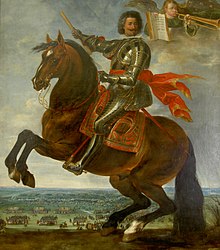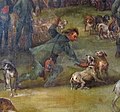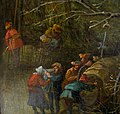Pieter Snayers

Pieter Snayers (born November 24, 1592 in Antwerp , † around 1667 in Brussels ; also Peeter or Petrus Snayers) was a Flemish painter . Snayers was best known for his decorative and topographical-analytical battle pictures.
life and work
Snayers was a student of Sebastian Vrancx (1573–1647), who is considered to be the inventor of battle painting in the Netherlands. In 1613 Snayers became a free master of the Guild of Luke and married the niece of the painter Cornelius Schut . In 1628 he went to Brussels as a court painter, where Adam Frans van der Meulen became his pupil. Snayers became the official battle painter of the House of Habsburg and painted the victories without ever having attended a battle. He produced huge battle cycles for the Spanish court, for Archduke Leopold Wilhelm , Count Bonaventura von Bucquoy and Octavio Piccolomini, among others . Snayers must have had a large workshop, as he would not have been able to handle the huge commissions, this large number of monumental battle paintings, on his own. For example, he painted the so-called piccolomic series of twelve large-format battle paintings, which are now in the Army History Museum in Vienna , between 1639 and 1651 . Snayers not only painted the aforementioned major battle cycles, but also smaller war scenes, equestrian battles and hunts.
The type of battle painting by Pieter Snayer
A relatively large number of large-scale battle paintings from the Thirty Years' War by Pieter Snayers have survived , most of which can be assigned to the category of the topographical-analytical battle picture. This form of representation was intended for specialist circles of the military as a target audience, reproduced a more or less unadulterated representation of the historical battle and represented the pictorial counterpart to the printed battle relations. Pieter Snayers is probably the main master of this genre. His works show the military formations from a bird's eye view in a high-horizon landscape. The presentation is distinguished by the accuracy with which the tactical movements of the individual branches of the army, pikemen , musketeers and cavalry , are recorded. Snayers, who himself was never personally present at a battle, mostly used engraving templates that were made by military engineers such as the imperial engineer-captain Carlo Cappi and partly adopted and published by Matthäus Merian in the Theatrum Europaeum .
The paintings are divided into three zones: In the foreground you can usually see the genre figure and / or the commanding general. In the center of the picture is the recording of the tactical maneuvers of the individual military departments, and in the last third of the picture the landscape merges in bluish stripes into a calm sky. The size of these three zones can vary, depending on how much space the main event takes up in the middle zone. In his foreground groups, Pieter Snayers depicts almost all aspects of the military life of his time. There, the soldier who binds his sore foot (cf. "The Battle of Lützen", Vienna, Heeresgeschichtliches Museum) has his place as does the victorious general . In the illustrations are just as camp followers to find as scrapping soldiers - in short, all the figures of the military genre. In addition to the descriptions of camp life with tents, the horrors of war and death on the battlefield can also be seen in these scenes.

Works (excerpt)
- The battle of the White Mountain . Oil on canvas, Bavarian Army Museum Ingolstadt .
- Cavalry battle , after 1634, oil on canvas, 74.5 × 109.2 cm, The Trustees of Dulwich Picture Gallery , London
- The battle of Lützen . Oil on canvas, 202 × 282 cm. KHM , Inv. No. GG1820 on permanent loan to the Army History Museum in Vienna.
- The Relief of Lions . Oil on canvas, 202 × 286 cm. KHM, Inv. No. GG18120 on permanent loan to the Army History Museum in Vienna.
- The transition over the Somme . Oil on canvas, 202 × 284 cm. KHM, Inv. No. GG1823 on permanent loan to the Army History Museum in Vienna.
- The Relief of St. Omer . Oil on canvas, 201 × 284 cm. KHM, Inv. No. GG1813 on permanent loan to the Army History Museum in Vienna.
- The attack on Grancourt near Thionville . Oil on canvas, 199 × 270 cm. KHM, Inv. No. GG1816 on permanent loan to the Army History Museum in Vienna.
- The Battle of Thionville . Oil on canvas, 202 × 267 cm. KHM, Inv. No. GG1814 on permanent loan to the Army History Museum in Vienna.
- The defeat at Grancourt . Oil on canvas, 202 × 281 cm. KHM, Inv. No. GG1815 on permanent loan to the Army History Museum in Vienna.
- The capture of the city of Neunburg am Walde . Oil on canvas, 202 × 267 cm. KHM, Inv. No. GG1817 on permanent loan to the Army History Museum in Vienna.
- The post office near Pressnitz . Oil on canvas, 202 × 267 cm. KHM, Inv. No. GG1618 on permanent loan to the Army History Museum in Vienna.
- The Siege of Einbeck . Oil on canvas, 202 × 285 cm. KHM, Inv. No. GG1819 on permanent loan to the Army History Museum in Vienna.
- The relief of Freiberg in Meissen . Oil on canvas, 202 × 264 cm. KHM, Inv. No. GG1821 on permanent loan to the Army History Museum Vienna.
- The affair near Munich . Oil on canvas, 203 × 280 cm. KHM, Inv. No. GG1822 on permanent loan to the Army History Museum in Vienna.
- Enclosing a city . Oil on canvas, 106 × 137 cm - Army History Museum, Vienna
- Siege of a fortress . Oil on canvas, 106 × 137 cm - Army History Museum, Vienna
- Swedish horsemen attack a convoy . Oil on canvas, 74 × 104 cm - Army History Museum, Vienna
- Great cavalry battle . Oil on canvas, 194 × 262 cm - Kunsthistorisches Museum Wien, Gemäldegalerie - Inv.-No. GG_628
- The siege of Valenza del Po . Oil on canvas, 165 × l92 cm - German Historical Museum , Berlin - Inv.-No .: Gm 94/2
- Portrait of Charles Bonaventure de Longueval, Comte de Bucquoy at the Battle of the White Mountain . Oil on canvas, Rohrau Castle , Count Harrach's family collection.
gallery
Particularly noteworthy are the foreground groups typical of Pieter Snayers in his topographical-analytical battle pictures. Here, apart from the otherwise precisely reproduced battle, the artist describes harrowing, exhilarating and everyday episodes of the military genre in the Thirty Years' War:
literature
- Joseph Eduard Wessely : Snayers, Pieter . In: Allgemeine Deutsche Biographie (ADB). Volume 34, Duncker & Humblot, Leipzig 1892, p. 500.
- Walter F. Kalina: The Piccolomini series by Pieter Snayer. Twelve battle paintings in the Vienna Army History Museum , in: Viribus Unitis. Annual report of the Army History Museum 2005. Vienna, 2006. ISBN 3-902551-01-1 .
- Walter F. Kalina: Painting for the General. Pieter Snayers´ Piccolimini Cycle , in: Ulrike Gehring, Peter Weibel (eds.): Mapping spaces. Networks of Knowledge in 17th Century Landscape Painting , Hirmer Verlag , Munich 2014, ISBN 978-3-7774-2230-5 , pp. 254-257.
- Matthias Pfaffenbichler: The battle picture in the late 16th and 17th centuries. Dissertation University of Vienna, 1987.
- Johann Christoph Allmayer-Beck : The Army History Museum Vienna. Hall I - From the beginnings of the standing army to the end of the 17th century , Salzburg 1982, pp. 76–96.
- Giancarlo Sestieri: Battle Painters. Italian and Foreign Masters of the XVII and XVIII centuries . DeLuca, Rome 1999, ISBN 88-8016-321-3 .
Web links
- Documentation - Walter Kalina, art historian in the Heeresgeschichtliches Museum about Pieter Snayers (2019).
Individual evidence
- ↑ Helge Siefert, To the glory of the hero. History and genre painting of the 17th and 18th centuries, Munich 1993, 194
- ↑ Jane Turner (ed.), The Dictionary of Art. London 1996, 28,898
- ^ Matthias Pfaffenbichler, The battle picture in the late 16th and 17th centuries. Dissertation University of Vienna, 1987, 149.
- ^ Walter F. Kalina: The piccolo series of Pieter Snayers. Twelve battle paintings in the Army History Museum. in: Viribus Unitis. Annual report of the Army History Museum 2005, Vienna 2006, 87f.
- ↑ On the categorization of the battle pictures: Matthias Pfaffenbichler, The battle picture in the late 16th and 17th centuries. Dissertation University of Vienna, 1987
- ↑ Johann Christoph Allmayer-Beck : The Army History Museum Vienna. Hall I - From the beginnings of the standing army to the end of the 17th century, Salzburg 1982 pp. 77, 90, 91, 92.
- ↑ Klaus Bußmann , Heinz Schilling : 1648 - War and Peace in Europe. Catalog volume and two text volumes, Münster 1998 [Documentation of the Council of Europe exhibition on the 350th anniversary of the Peace of Westphalia in Münster and Osnabrück.] Münster / Osnabrück 1998, ISBN 3-88789-127-9 , p. 145
- ^ Manfried Rauchsteiner , Manfred Litscher: Das Heeresgeschichtliche Museum in Wien , Verlag Styria , Vienna 2000, ISBN 3-222-12834-0 , p. 12
- ↑ Klaus Bußmann , Heinz Schilling : 1648 - War and Peace in Europe. Catalog volume and two text volumes, Münster 1998 [Documentation of the Council of Europe exhibition on the 350th anniversary of the Peace of Westphalia in Münster and Osnabrück.] Münster / Osnabrück 1998, ISBN 3-88789-127-9 , p. 94 f.
| personal data | |
|---|---|
| SURNAME | Snayers, Pieter |
| ALTERNATIVE NAMES | Snayers, Peeter; Snayers, Peter |
| BRIEF DESCRIPTION | Flemish painter |
| DATE OF BIRTH | November 24, 1592 |
| PLACE OF BIRTH | Antwerp |
| DATE OF DEATH | around 1667 |
| Place of death | Brussels |







